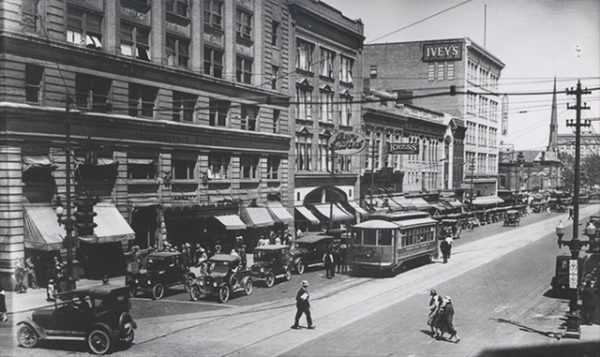Uptown time traveler

How has uptown Charlotte changed in the past century? Launch the map below for an interactive graphic that depicts the dramatic change since 1911. A century ago, uptown’s urban pattern was fine-grained, with numerous small buildings on small lots.
Today that fine-grained fabric has been lost. The modern projects have giant-sized footprints, often taking up a whole block (launch map using link below). The map has photos of historic spots, and what’s there today. To explore in greater detail, visit Charlotte1911.org.
You may also view the interactive graphic as part of a touch screen display in the lobby of Levine Museum of the New South, produced in cooperation with the UNC Charlotte Urban Institute and the Renaissance Computing Institute at UNC Charlotte.
The time-travel map is based on work done in a collaboration between the Levine Museum and UNC Chapel Hill University Library called Main Street, Carolina. Included in that collaboration is a larger set of data on the center of Charlotte circa 1911 that allows you to explore where people lived and what kinds of work they did.
The underlying map from 1911 comes from the The Sanborn Map Company, (today known as Sanborn) which produced specialized maps for fire insurance companies for decades after its founding in 1866. Those maps contain rich information that has been of great interest to historians. For more on these maps and how they are being used: http://www.loc.gov/rr/geogmap/sanborn/san4a1.html
.btnLaunch { -moz-box-shadow:inset 0px 1px 0px 0px #ffffff; -webkit-box-shadow:inset 0px 1px 0px 0px #ffffff; box-shadow:inset 0px 1px 0px 0px #ffffff; background:-webkit-gradient( linear, left top, left bottom, color-stop(0.05, #ededed), color-stop(1, #dfdfdf) ); background:-moz-linear-gradient( center top, #ededed 5%, #dfdfdf 100% ); filter:progid:DXImageTransform.Microsoft.gradient(startColorstr=’#ededed’, endColorstr=’#dfdfdf’); background-color:#ededed; -moz-border-radius:6px; -webkit-border-radius:6px; border-radius:6px; border:1px solid #dcdcdc; display:inline-block; color:#777777; font-family:arial; font-size:24px; font-weight:bold; padding:20px 60px; text-decoration:none; text-shadow:1px 1px 0px #ffffff;
}.btnLaunch:hover { background:-webkit-gradient( linear, left top, left bottom, color-stop(0.05, #dfdfdf), color-stop(1, #ededed) ); background:-moz-linear-gradient( center top, #dfdfdf 5%, #ededed 100% ); filter:progid:DXImageTransform.Microsoft.gradient(startColorstr=’#dfdfdf’, endColorstr=’#ededed’); background-color:#dfdfdf;
}.btnLaunch:active { position:relative; top:1px;
}
/* This imageless css button was generated by CSSButtonGenerator.com */ //Created an array to hold onto the desired info. var windowSizeArray = [ “width=1000,height=1000″,”width=300,height=400,scrollbars=yes” ]; $(document).ready(function(){ //Links that has the “.newWindow” class will call this script. $(‘.newWindow’).click(function (event){ // Gets the URL from the clicked link. var url = $(this).attr(“href”); /*Gets the name from the clicked link. Currently I commented out the jquery script and just put “popUp” for a default name because I didn’t include the name in the links.*/ var windowName = “popUp”;//$(this).attr(“name”); /*Places the string from the array into the windowSize variable. The array slot is determined by the “rel” number on the link.*/ var windowSize = windowSizeArray[ $(this).attr(“rel”) ]; //This method opens a new browser window. window.open(url, windowName, windowSize); /*Prevents the browser from executing the default action and allows us to use the “window.open” within our script.*/ event.preventDefault(); }); });